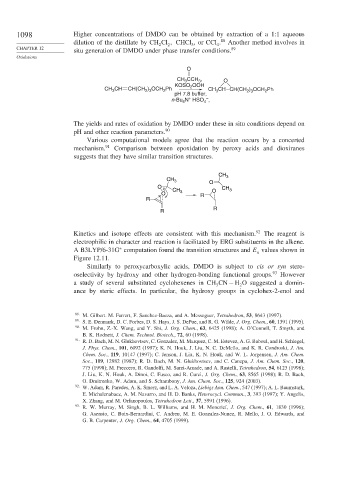Page 1122 - Advanced Organic Chemistry Part B - Reactions & Synthesis
P. 1122
1098 Higher concentrations of DMDO can be obtained by extraction of a 1:1 aqueous
dilution of the distillate by CH Cl CHCl ,orCCl . 88 Another method involves in
3
2
2
4
CHAPTER 12 89
situ generation of DMDO under phase transfer conditions.
Oxidations
O
CH CCH , O
3
3
KOSO OOH
2
) OCH Ph
CH 3 CH CH(CH ) OCH Ph CH CH CH(CH 2 3 2
2
2 3
3
pH 7.8 buffer,
+
–
n-Bu N HSO ,
4
4
The yields and rates of oxidation by DMDO under these in situ conditions depend on
pH and other reaction parameters. 90
Various computational models agree that the reaction occurs by a concerted
mechanism. 91 Comparison between epoxidation by peroxy acids and dioxiranes
suggests that they have similar transition structures.
CH 3
CH 3 O
O CH CH 3
O 3 R O
R
R
R
Kinetics and isotope effects are consistent with this mechanism. 92 The reagent is
electrophilic in character and reaction is facilitated by ERG substituents in the alkene.
A B3LYP/6-31G computation found the transition structures and E values shown in
∗
a
Figure 12.11.
Similarly to peroxycarboxylic acids, DMDO is subject to cis or syn stere-
oselectivity by hydroxy and other hydrogen-bonding functional groups. 93 However
a study of several substituted cyclohexenes in CH CN −H O suggested a domin-
3 2
ance by steric effects. In particular, the hydroxy groups in cyclohex-2-enol and
88 M. Gilbert. M. Farrert, F. Sanchez-Baeza, and A. Messeguer, Tetrahedron, 53, 8643 (1997).
89
S. E. Denmark, D. C. Forbes, D. S. Hays, J. S. DePue, and R. G. Wilde, J. Org. Chem., 60, 1391 (1995).
90 M. Frohn, Z.-X. Wang, and Y. Shi, J. Org. Chem., 63, 6425 (1998); A. O’Connell, T. Smyth, and
B. K. Hodnett, J. Chem. Technol. Biotech., 72, 60 (1998).
91
R. D. Bach, M. N. Glukhovtsev, C. Gonzalez, M. Marquez, C. M. Estevez, A. G. Baboul, and H. Schlegel,
J. Phys. Chem., 101, 6092 (1997); K. N. Houk, J. Liu, N. C. DeMello, and K. R. Condroski, J. Am.
Chem. Soc., 119, 10147 (1997); C. Jenson, J. Liu, K. N. Houk, and W. L. Jorgensen, J. Am. Chem.
Soc., 119, 12982 (1987); R. D. Bach, M. N. Glukhovtsev, and C. Canepa, J. Am. Chem. Soc., 120,
775 (1998); M. Freccero, R. Gandolfi, M. Sarzi-Amade, and A. Rastelli, Tetrahedron, 54, 6123 (1998);
J. Liu, K. N. Houk, A. Dinoi, C. Fusco, and R. Curci, J. Org. Chem., 63, 8565 (1998); R. D. Bach,
O. Dmitrenko, W. Adam, and S. Schambony, J. Am. Chem. Soc., 125, 924 (2003).
92 W. Adam, R. Paredes, A. K. Smerz, and L. A. Veloza, Liebigs Ann. Chem., 547 (1997); A. L. Baumstark,
E. Michalenabaez, A. M. Navarro, and H. D. Banks, Heterocycl. Commun., 3, 393 (1997); Y. Angelis,
X. Zhang, and M. Orfanopoulos, Tetrahedron Lett., 37, 5991 (1996).
93
R. W. Murray, M. Singh, B. L. Williams, and H. M. Moncrief, J. Org. Chem., 61, 1830 (1996);
G. Asensio, C. Boix-Bernardini, C. Andreu, M. E. Gonzalez-Nunez, R. Mello, J. O. Edwards, and
G. B. Carpenter, J. Org. Chem., 64, 4705 (1999).

